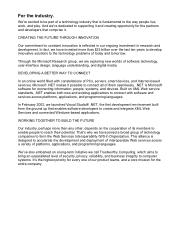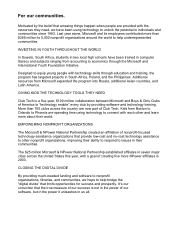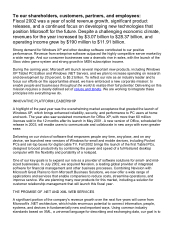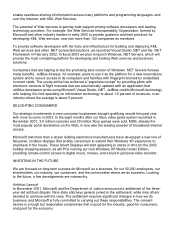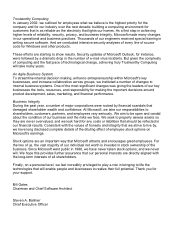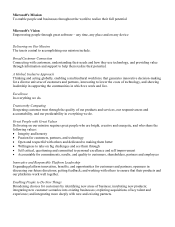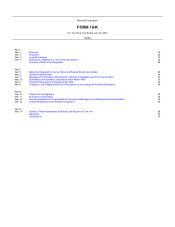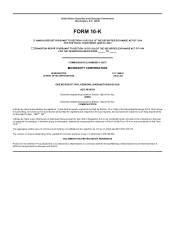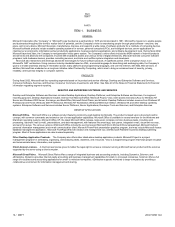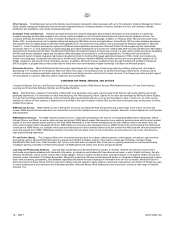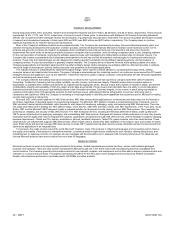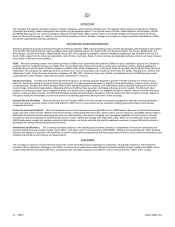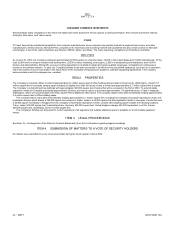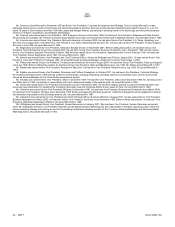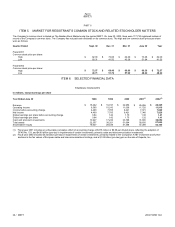Microsoft 2002 Annual Report Download - page 14
Download and view the complete annual report
Please find page 14 of the 2002 Microsoft annual report below. You can navigate through the pages in the report by either clicking on the pages listed below, or by using the keyword search tool below to find specific information within the annual report.
MSFT 16 / 2002 FORM 10-K
Part I
Item 1
PART I
ITEM 1. BUSINESS
GENERAL
Microsoft Corporation (the “Company” or “Microsoft”) was founded as a partnership in 1975 and incorporated in 1981. Microsoft’s mission is to enable people
and businesses throughout the world to realize their full potential, and the Company’s vision is empowering people through great software—any time, any
place, and on any device. Microsoft develops, manufactures, licenses, and supports a wide range of software products for a multitude of computing devices.
Microsoft software products include scalable operating systems for servers, personal computers (PCs), and intelligent devices; server applications for
client/server environments; information worker productivity applications; business solutions applications; and software development tools. During fiscal 2002,
Microsoft launched Xbox, the Company’s next-generation video game system. The Company’s online efforts include the MSN network of Internet products
and services and alliances with companies involved with broadband access and various forms of digital interactivity. Microsoft licenses consumer software
programs; sells hardware devices; provides consulting services; and trains and certifies system integrators and developers.
Microsoft also researches and develops advanced technologies for future software products. A significant portion of the Company’s focus is on
Microsoft’s .NET architecture. Using common industry standards based on XML, a universal language for describing and exchanging data, the Company’s
goal is to enable seamless sharing of information across many platforms and programming languages, and over the Internet, with XML Web services. In
addition, Microsoft has embarked on a long-term initiative called Trustworthy Computing, which aims to bring an enhanced level of security, privacy,
reliability, and business integrity to computer systems.
PRODUCTS
During fiscal 2002, Microsoft had four operating segments based on its product and service offerings: Desktop and Enterprise Software and Services;
Consumer Software, Services, and Devices; Consumer Commerce Investments; and Other. See Note 20 of the Notes to Financial Statements for financial
information regarding segment reporting.
DESKTOP AND ENTERPRISE SOFTWARE AND SERVICES
Desktop and Enterprise Software and Services includes Desktop Applications; Desktop Platforms; and Enterprise Software and Services. For segment
reporting purposes, Desktop Applications includes revenue from Microsoft Office; Microsoft Project; Visio; client access licenses (CALs) for Windows NT
Server and Windows 2000 Server, Exchange, and BackOffice; Microsoft Great Plains; and bCentral. Desktop Platforms includes revenue from Windows XP
Professional and Home; Windows 2000 Professional; Windows NT Workstation; Windows Millennium Edition; Windows 98; and other desktop operating
systems. Enterprise Software and Services includes Server Platforms; Server Applications; Developer Tools and Services; and Enterprise Services.
DESKTOP APPLICATIONS
Microsoft Office. Microsoft Office is a software product featuring commonly used desktop functionality. The product is based upon a document-centric
concept, with common commands and extensive use of cross-application capabilities. Microsoft Office is available in several versions for the Windows and
Macintosh operating systems. Microsoft Office XP, the latest Microsoft Office release, helps users complete common business tasks, including word
processing, electronic mail (e-mail), presentations, and data management, with features like smart tags, task panes, integrated e-mail, document recovery,
and send for review. The various versions of Microsoft Office include the word processor Microsoft Word, Microsoft Excel spreadsheet, Microsoft Outlook
personal information management and e-mail communication client, Microsoft PowerPoint presentation graphics program, and may include Microsoft Access
database management application, Microsoft FrontPage Web site creation and management tool, and Microsoft Publisher business desktop publishing
program. Most of these applications are also licensed separately.
Other Desktop Application Products. The Company also offers other stand-alone desktop application products. Microsoft Project is a project
management program for scheduling, organizing, and analyzing tasks, deadlines, and resources. Visio is a diagramming program that helps people visualize
and communicate ideas, information, and systems.
Client Access Licenses. A client access license gives its holder the legal right to access a computer running a Microsoft server product and the services
supported by the server using a client computer.
Microsoft Great Plains. Microsoft Great Plains offers a range of integrated business and accounting products, including Dynamics, Solomon, and
eEnterprise. Dynamics provides Internet-ready accounting and business management capabilities for small- to mid-sized companies. Solomon offers a full
range of e-business and accounting applications for small- to mid-sized companies. eEnterprise supports mid-sized to larger companies by providing a
collaborative environment for information management and sharing.


